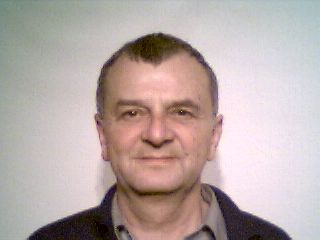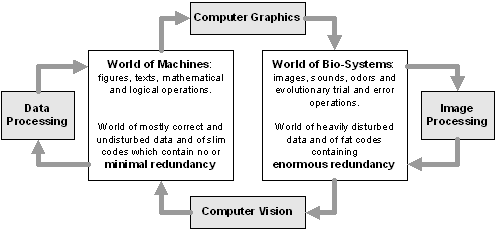
Image Processing: Introduction
Copyright © by V. Miszalok, last update: 2011-01-26
Let me know
what you think
| Home | Contents | Next >> |
 |
Image Processing: IntroductionCopyright © by V. Miszalok, last update: 2011-01-26 |
 Let me know what you think |
|
following Rosenfeld, Kak 1982
| Image | Conversion of a real world scene into a flat illumination pattern being
a function f(x,y) of two variables x∈IR and y∈IR, where x is the horizontal and y the vertical coordinate in a finite, rectangular, flat region. The function values are nonnegative bound brightnesses. |
| Discretization | Projection of an image on an M x N lattice and sampling it at an M x N array of points. |
| Quantization | Mapping the continuous range of brightnesses by a finite set of integer values such as 0 ... 255. |
| Binarization | Mapping the continuous range of brightnesses by two integer values such as 0 and 1. |
| Digital Image | Finite M x N array resulting from 1. discretization and 2. quantization. |
| Binary Image | Finite M x N array resulting from 1. discretization and 2. binarization. |
| Image Processing | Manipulates and analyzes digital images by computer. Synonyms: digital imaging, picture processing |
| Raster Graphics | Is a set of technologies and data structures aimed to represent digital images. |
| |
There is an important difference between digital images and usual computer data.
Digital images usualy contain an enormous amount of redundancy and interference.
They are directed at human eyes and the human visual cortex which are specialized in consuming heavily disturbed data streams.
| See: www.miszalok.de//Lectures/L01_Redundancy/Redundancy.htm |
Modern Computer Science since 1980

There are four types of how to handle REDUNDANCY in computer science:
| Caution: | |
| 1. | Do not confuse image processing IP with computer vision CV ! Both work with digital images but IP mostly generates images from images whereas CV eliminates redundancy and generates just a few measured values. |
| 2. | Do not confuse computer vision CV with image compression IC ! Both reduce redundancy but CV doesn't preserve any pictorial information whereas IC is intended to preserve the image as good as possible. |
| |
Nearly never digital images are composed by a human being,
because there is no economic way to select and arrange thousands or millions of pixels by hand.
(Rare exceptions: The antique, medieval and renaissance mosaics are sorts of hand-made raster graphics.)
Nowadays almost always a digital image comes out of a camera or a graphics card.
There are two main sources of digital images:
1. Scanning the real world:
digital photo, copier, TV, x-ray, CT, ultrasound, radar, weather satellite ...
2. Scanning vector graphics:
A graphics processor (= rasterizer) converts vector graphics into "Raster Graphics".
| Home | Contents | Next >> |
|